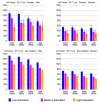Trends in absolute socioeconomic inequalities in mortality in Sweden and New Zealand. A 20-year gender perspective
- PMID: 16790061
- PMCID: PMC1526425
- DOI: 10.1186/1471-2458-6-164
Trends in absolute socioeconomic inequalities in mortality in Sweden and New Zealand. A 20-year gender perspective
Abstract
Background: Both trends in socioeconomic inequalities in mortality, and cross-country comparisons, may give more information about the causes of health inequalities. We analysed trends in socioeconomic differentials by mortality from early 1980s to late 1990s, comparing Sweden with New Zealand.
Methods: The New Zealand Census Mortality Study (NZCMS) consisting of over 2 million individuals and the Swedish Survey of Living Conditions (ULF) comprising over 100, 000 individuals were used for analyses. Education and household income were used as measures of socioeconomic position (SEP). The slope index of inequality (SII) was calculated to estimate absolute inequalities in mortality. Analyses were based on 3-5 year follow-up and limited to individuals aged 25-77 years. Age standardised mortality rates were calculated using the European population standard.
Results: Absolute inequalities in mortality on average over the 1980s and 1990s for both men and women by education were similar in Sweden and New Zealand, but by income were greater in Sweden. Comparing trends in absolute inequalities over the 1980s and 1990s, men's absolute inequalities by education decreased by 66% in Sweden and by 17% in New Zealand (p for trend <0.01 in both countries). Women's absolute inequalities by education decreased by 19% in Sweden (p = 0.03) and by 8% in New Zealand (p = 0.53). Men's absolute inequalities by income decreased by 51% in Sweden (p for trend = 0.06), but increased by 16% in New Zealand (p = 0.13). Women's absolute inequalities by income increased in both countries: 12% in Sweden (p = 0.03) and 21% in New Zealand (p = 0.04).
Conclusion: Trends in socioeconomic inequalities in mortality were clearly most favourable for men in Sweden. Trends also seemed to be more favourable for men than women in New Zealand. Assuming the trends in male inequalities in Sweden were not a statistical chance finding, it is not clear what the substantive reason(s) was for the pronounced decrease. Further gender comparisons are required.
Figures
References
-
- Evans L, Grimes A, Wilkinson B, Teece D. Economic Reform in New Zealand 1984–95: The Pursuit of Efficiency. Journal of Economic Literature. 1996;34:1856–1902.
-
- Dalziel P. New Zealand's Economic Reforms: An Assessment. Review of Political Economy. 2002;14:31–46. doi: 10.1080/09538250120102750. - DOI
-
- Philip W. An analysis of the economic democracy reforms in Sweden. Edwin Mellen Press; 2004.
-
- The Swedish National Public Health Report. Swedish National Board of Welfare and Health Services. 2004.
-
- Blakely T, Fawcett J, Atkinson J, Tobias M, Cheung J. Decades of Disparity II: Socioeconomic mortality trends in New Zealand 1981–1999. Wellington: Ministry of Health; 2005.
Publication types
MeSH terms
LinkOut - more resources
Full Text Sources



